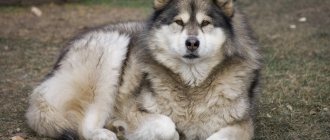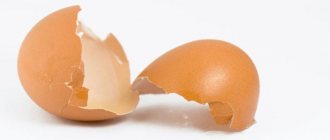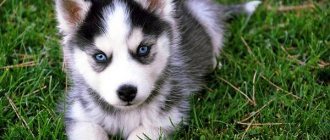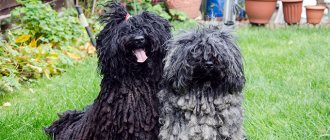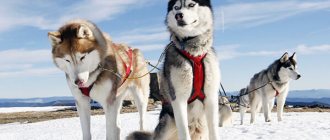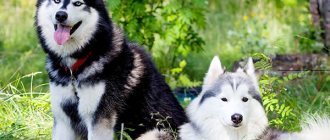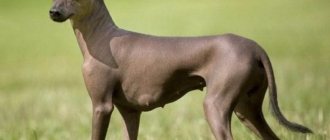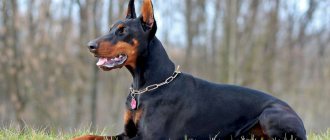Origin story
Husky is a collective name for a group of northern sledding breeds. Their purpose is to pull a team and transport small loads. These breeds are distinguished by their strength, endurance and ability to run fast.
The Chukchi are considered the “parents” of the husky. They crossed native species with wolves. The result was excellent working dogs capable of pulling sleds over vast distances. This made it possible to hunt large animals and expand the boundaries of their possessions. It was the Chukchi huskies that became the ancestors of the Siberian ones.
The Eskimos also appreciated wolf-like dogs and began to breed their own varieties. The name Husky comes from the abbreviation Eski: this is what Canadians called Eskimos. Northerners valued the breed not only for its fantastic endurance, but also for its unpretentiousness in food: they could be fed dry fish.
Sled dogs played an important role in the lives of their owners. They were full members of the tribe and were highly respected. According to some customs, huskies were invited into the house after the birth of a child and the dogs were allowed to warm the baby.
The Husky group includes:
- Siberian;
- Alaskan;
- Sakhalin;
- Japanese;
- Klee Kai (mini husky).
They have comparable performance data, but differ in appearance, character and habitat.
Key points in training
Huskies are pack dogs, they have a desire for leadership or follow the leader if there is a strong leader in the group. Therefore, the owner needs to show his strength and inflexibility all the time, from the first days of the puppy’s life. Otherwise, the dog will become the main one both in the house and in the family, and will be uncontrollable.
This breed practically does not feel pain, so rough training methods simply will not work. In order to show that the pet is wrong, a stern look, deprivation of treats, or isolating the animal in an enclosure or room is enough. As a last resort, you can pin the dog to the ground and hold it until it calms down.
Sled dogs begin to be trained at 3-4 months, when they remember their name and daily routine. You can contact canine services. Huskies are quite stubborn, but they learn quickly, copy the habits of other animals, and collective training suits them.
Training begins with basic commands that allow you to control your pet:
- "Near";
- "Sit";
- "It is forbidden";
- "Place".
After this, complex techniques are studied:
- "Lie";
- "Somersault";
- "Voice";
- "Quiet".
When the dog remembers voice commands, you can switch to claps or whistles. You definitely need to reward your pet with treats, but only when he deserves them.
Read about how to properly train a dog in the article: “Training a puppy: effective methods from dog handlers, learning commands at home.”
Alaskan Husky
This variety is a mixed breed group that includes crosses of aboriginal breeds, malamutes, Siberian huskies and even pointers. It is formed on the basis of performance characteristics. Currently, the group of Alaskan huskies includes all non-northern sled breeds (or northern ones, but not registered in the FCI). Huskies came to the peninsula along with traders. Alaskans do not have a traditional breed standard. Individuals up to 66 cm tall and weighing up to 27 kg take part in the races.
General description:
- The head is cone-shaped, the muzzle is rectangular, tapered towards the end.
- The jaws are strong, with a strong grip, scissor bite.
- The eyes are almond-shaped, medium in size. The iris is colored blue, yellowish or brown.
- The ears are erect, triangular, set high, with pointed tips.
- The body is strong, with pronounced muscles. The outlines are rectangular.
- The tail is high-set, curled into a ring, and abundantly covered with hair. Usually thrown on the back.
- The limbs are strong, straight and muscular. Very powerful, with strong bones.
- Paws are oval shaped.
The coat is less dense than that of the Siberian Husky. Guard hairs of different lengths. This helps distribute the heat during a long run. The undercoat is thick and abundant. The color can be of any shade.
Alaskans are distinguished by their gentle nature and do not show zoo aggression. They love spending time with their relatives and often try to attract the attention of an unfamiliar dog. They are also highly trainable and not prone to dominant behavior.
Alaskans are naturally jumpy, easily overcoming a 2-meter fence. The owner will have to surround the house with a high fence.
Types by coat type
Smooth-haired
The coat is two-layered, medium in length, and can be more or less short in different parts of the body. It consists of a dense and dense, but at the same time soft undercoat and a tougher spine adjacent to the body. During shedding, the undercoat comes out completely, making the dog look sleeker than usual.
Longhair
Long-haired huskies look very elegant, as their elongated hair forms beautiful fringes in the form of a mane and pants. The tail of the longtails is very fluffy, similar to a plume. However, despite the fact that long hair looks very elegant, according to the requirements of the standard, it is considered a serious fault.
IMPORTANT!
The long-haired husky is a good pet, but you should not expect such a pet to become a show winner.
Siberian Husky
Siberian Huskies are indigenous dog breeds bred by the peoples of the Far North. This breed is genetically close to the wolf. During the Gold Rush it was imported to North America, where it became widespread due to its performance characteristics. Oddly enough, in their homeland, huskies were considered insufficiently promising and were excluded from breed registries. Dog breeding began in the USA, where the official standard was established.
Breed standard:
- Dimensions: height up to 60 cm, weight up to 27 kg.
- The head is medium in size, regular in shape, tapering from the back of the head to the eyes. The muzzle tapers slightly towards the nose. The nose is large, with well-cut nostrils. Its color depends on the type of color.
- The eyes are almond-shaped, medium in size. The iris is colored blue or brown.
- The jaws are powerful, well developed, with a scissor bite.
- The chest is of moderate breadth, set deep.
- The tail is sickle-shaped, similar to a fox. Should not be thrown on the back or hanging from the side.
- Limbs are straight and powerful.
- The body is strong, with well-developed muscles, and harmonious proportions.
The coat is straight and of medium length. The structure is not rough, soft. The coat is abundant and dense, effectively protecting against the cold. The undercoat is thick and well developed. May be absent during seasonal molts.
The color palette is very diverse. Siberians can be:
- white;
- gray-white;
- silvery white;
- red;
- chocolate;
- fawn;
- wolf color;
- sable;
- agouti;
- piebald;
- marble;
- splash coat;
- black-and-white;
- isabella;
- black.
There are about 20 types of colors in total.
Siberian Huskies have a friendly, affable disposition. They are not prone to aggression and cannot be guard dogs. This breed enjoys good health, but is prone to eye diseases, dermatitis and laryngeal paralysis.
Varieties
Siberian Husky
The species was bred, surprisingly, in the USA by crossing sled dogs from Alaska and Siberia. It exists in its modern, familiar form due to the efforts of breeders who set themselves an interesting goal - to turn a heavy truck running in a harness into a dog adapted to life in the city. Now it is mainly a house companion, although it is very energetic and constantly requires activity.
Their appearance is the most classic. They grow up to 60 centimeters in height, with an average weight of 30 kilograms. These human companions are extremely clean, do not smell like other dogs, and therefore live even in families with allergies. The coat is thick, with a soft undercoat. Only during shedding does it need to be brushed every day, but the rest of the time not so often - only once a week. They love physical activity, are friendly and welcoming, and love to hunt, so living in the same territory with rodents sometimes leads to unpleasant incidents. “Girls” exhibit more hunting instincts than “boys.” But don't worry - your furry companion hunts just for fun and would never kill a hamster or bird. It is not used as a security guard, as it is good-natured and will calmly approach a stranger.
IMPORTANT! If you need a home protector, get another animal. But if you are looking for a source of good mood and a family favorite, this is the best choice.
On average, dogs live a long life - from 12 to 15 years, and some record holders - even up to 25 years. Blue-eyed handsome men are not prone to hereditary diseases and are distinguished by good health (how could it be otherwise for a northern resident?). Their love of physical activity plays to their advantage - it prolongs their life. So, with proper care, your friend will live longer, even 20 years. Here everything depends entirely on its owner.
There are practically no allergies to it. Such a four-legged companion will frighten a robber with its stern appearance. He loves outdoor games more than other dogs. He especially enjoys taking passengers on sleds and running races. Dogs cannot bark, but they can “sing” and howl like a real wolf. They will never bite a person (few four-legged animals can boast of this). Their training should only be soft, non-violent - they cannot tolerate any other approach. And they make excellent companions for children and the rest of the family.
Important! Representatives of the breed are often confused with huskies.
KEY DIFFERENCES
- Huskies cannot bark or bark;
- huskies smell;
- Blue-eyed dogs have better immunity and shorter hair.
Sakhalinskaya
This is a working sled type. Its other name is “karafuto-ken,” which translated from Japanese means “Sakhalin dog.” These are the closest relatives of the breeds: Akita Inu and Japanese Spitz. They themselves belong to the Spitz type. The dog's height reaches 66 centimeters, weight reaches 40 kilograms. All animals have good muscles and strong bones. They are smart, calm, even calm. Now on the verge of extinction, only a few breeders in Russia and Japan continue to support the population. The reasons for the disappearance are cited as an unsuccessful attempt to cross several types of sled dogs and breed the Far Eastern Laika, which happened back in Soviet times.
Yakutskaya
That animal that we call that by mistake is actually a husky. It was bred as a sled dog by indigenous peoples. The Yakut population uses the word “sakha yta” for its name, that is, Yakut dog. This is a strong, muscular beast; in appearance, however, it can easily be confused with its northern brothers. Only his eyes are straight, wide-set, his fur is thicker, with a developed mane, and his color is usually spotted, richer in variety than that of his famous relative.
Japanese
This is often said about the Akita Inu. But they look very different in appearance. Akita Inu is a long-haired dog with a wide triangular head, small eyes, erect ears and a tail curled into a ring. The weight of such a handsome man is up to 45 kilograms, and his height is up to 70 centimeters. And its color is more varied, but most often brindle, red and white and white. The famous representative is Hachiko, about whom they even made a film in Hollywood.
IMPORTANT! Akita Inu is a completely different breed.
American
This is what the Eskimo husky is often called. She is closely related to her Siberian “friends”, but differs mainly in that she is completely unsuited to living in an apartment. She has the freedom to live in the private sector, where it is possible to arrange a large enclosure for her pet. And our American brothers also love to run.
Alaskan
It is not recognized as a subspecies by the International Canine Association. It differs from its relative in having less dense and shorter hair, mixed genetic kinship, which is why it is not recognized by the commission. When breeding it, German shepherds, border collies and Alaskan malamutes were involved.
IMPORTANT! Not recognized as a subspecies by the International Canine Association. Not used as an exhibition.
Baikalskaya
In the village of Listvyanka in Russia there is a nursery whose breeders claim that they have bred a special subspecies - the Baikal one. In comparison with the Kamchatka “brothers,” as the owner says, these dogs’ body structure has changed slightly; they are much faster and more resilient, but are not adapted for extreme frosty latitudes. Also not yet recognized by the International Association.
Finnish
In Finland they also breed their four-legged friends. It is rather a variety resulting from crossing Siberian Huskies and racing breeds. They tolerate low temperatures well and love to walk in harness. Riding tours with them are very popular in Finland.
Kamchatskaya
Kamchatka also has its own nursery, in which a separate subspecies is bred, and it is called Kamchatka. Bred to compete in the annual Beringia Sled Dog Race. Race participants travel more than thousands of kilometers in severe frost, so these dogs are more adapted to the extremely low temperatures of the north than other subspecies.
REFERENCE
- there are many varieties of the breed;
- these are not always true subspecies of husky;
- Sakhalin, Yakut and American dogs are most similar to their famous brother;
- There are representatives of the family that are not recognized by the International Canine Association (Alaskan, Kamchatka, Finnish and Baikal).
Anyone from a glorious family of blue-eyed handsome men is a reliable friend of man. Each dog has its own characteristics that make it so memorable. It’s not for nothing that these animals are loved and valued in different parts of the world and are willing to pay a lot of money for such a puppy. Because sincere love and the wonderful character of the new family member will pay off everything a hundredfold.
Husky mini (Klee Kai)
Klee Kai is an original breed, bred in the USA in the 70-80s by Linda Spurlen and Eileen Gregory. The Klee Kai was probably the result of crossing Alaskan and Siberian Huskies. The creators of the breed have not yet “declassified” the data. Klee Kais are modest in size: the toy variety grows up to 33 cm, the standard Klee Kai - up to 42. Their weight ranges from 4 to 10 kg.
Mini-huskies are distinguished by a characteristic mask on their face and a tail curled into a donut. Overall, this is a miniature, well-built dog with a fluffy, thick coat. Klee Kais can be colored black and white, gray and white, and fawn.
They are known for their easy-going, playful nature and cat habits. Mini Huskies are great companions and get along well with animals. Due to the youth of the breed, they do not have genetic diseases, but 1 in 100 individuals suffer from blood diseases.
Common colors
No two huskies are alike: from birth, each puppy has its own coat pattern and color. But you can group the most common suits into separate types.
Black and white
With this type of color, the amount of white and black is approximately equal. The dark part of the coat is on top, the light part is located below. There may be areas with red spots on the back of the thighs.
Black and white color comes in 2 types:
- the hairs are fully pigmented, the shade of the undercoat is gray or black - such dogs look more expressive in person and in photos;
- the hairs are half pigmented, and the undercoat is white or gray.
Red and brown shades
Brown-white
It comes in different expressions - from rich dark to light cream colors. Depending on the concentration of pigment on the hairs, there are 2 subtypes of brown color:
- chocolate – darker and more pronounced;
- copper: lighter than chocolate, different shades - from bright to muted.
In the photo: on the left is a chocolate husky, on the right is a copper one
Red and white
It is also called red. Saturation depends on the pigment concentration. Dogs with bright fur appear fiery, while dogs with muted coats appear light red.
In the photo: fiery red shades (husky on the left, malamute on the right)
Because of this perception of colors, the red color is written as anything - from brown to fawn. This is not considered a mistake. In addition, during the first molt, puppies change color slightly. So don’t be surprised if the color of a pet with a light brown coat is designated as “red” in the passport.
Pale yellow
Close to red. However, it is not saturated, but muted tones - light brown, cream, golden.
Gray shades
Grey
The undercoat can be silver, gray, cream, fawn. And guard hair is found in 3 variations:
- black in combination with white - sometimes this color is considered black and white;
- only the ends of the hair are black;
- the ends of the hair are colored in a non-intense, as if muted black - giving the fur coat a bluish-silver tint.
The latter variation is often classified as a separate color type - silver. Although this is just a variation of the gray color of the husky.
Wolf
It is also called zonal, sometimes and mistakenly called gray. Most of the first representatives of the breed were wolf in color, but breeders relied on other colors, considering them more beautiful.
In the photo: wolf-colored husky. On the right - can also be classified as agouti.
The wolf color combines a beige undercoat with gray guard hair and splashes of brown. Tan marks are most often located on the back of the head, neck, ears, and limbs.
Sakhalin Husky
Sakhalin Huskies are one of the oldest aboriginal breeds of the Nivkhs (a people living in the Amur region and Sakhalin). The historical name of the breed is Gilyak. They were used as sled and draft dogs. The breed was distinguished by its endurance and extreme unpretentiousness. During the winter season they were fed dried fish once a day. Currently, the Sakhalin people are almost extinct.
In appearance, they resemble a mix of Husky, Akita Inu and Spitz. In addition, Sakhalin residents are the largest representatives of the group. Males grow up to 70 cm and weigh up to 40 kg. The physique is distinguished by strong bones and well-developed muscles. The head is large, the muzzle tapers towards the nose. The ears are set high, triangular and fluffy. The coat is thick and abundant. The undercoat is dense and well developed. Pile length may vary. Available in all sorts of colors. The most common breeds are black, red, gray and brindle huskies. In the past, each color had its own cultural and religious meaning.
Sakhalin residents have a strong, fearless character, but need constant communication with their owner. Abandoned dogs become nervous and destructive. This species is prone to dominant behavior (especially males) and therefore requires firm and decisive leadership. Sakhalin residents do not know fatigue and can pull a team around the clock. These dogs require constant exercise.
Japanese Husky (Akita Inu)
Japanese Husky is the popular name for Akita Inu. They are one of the 14 oldest indigenous breeds. The Akita Inu's homeland is the Japanese island of Honshu. Traditionally used as watchdogs and hunting dogs. During the Second World War, the Akita was actively used as a service dog, so the owners began to cross it with a German shepherd in order to avoid being sent to the front (at that time, German shepherds were under state protection).
The Akita Inu is a Spitz-shaped dog that looks like a large husky. The Japanese grow up to 70 cm and weigh up to 40 kg. They are distinguished by a harmonious physique and long, dry limbs. The ears are triangular and set high. Almond-shaped eyes are set wide apart. The coat is thick and of varying lengths. The undercoat is abundant and soft. Color can be white, brindle and white-red.
These dogs are known for their calm nature and ability to be trained. A sharp mind allows them to make independent decisions. Akita Inu are prone to self-will and stubbornness. At the same time, they are brave, friendly and loyal dogs.
Varieties: name, description and photo
Thanks to many years of breeding work, there are many varieties of the Husky breed in the world . Each has its own distinctive features. Next, we will describe in detail what types there are, in addition to the well-known Siberian ones, and what are their differences, we will present a description of their character and photos of dogs.
Siberian
Siberian Huskies on a walk:
Mom and puppy are resting:
The most common breed, popular all over the world.
Sakhalin
Sakhalin Husky on a walk:
Resting after a walk:
A larger breed, up to 65 cm tall, weighing 30-40 kg. Loyal but freedom-loving dogs. Lifespan – 15 years. They perform well both as hunting dogs and as companions . The price of a Sakhalin Husky varies from 200 to 600 dollars.
These dogs are easy to train, but do not tolerate rough handling. When training, you need to be patient and kind.
Character
Huskies are sled dogs that have lived side by side with people for centuries. This made them capable of dialogue and real, sincere friendship. Northerners are friendly towards strangers and will not be able to act as a security guard.
Huskies have a special affection for children. They love outdoor games and are always ready to cuddle. These dogs make excellent nannies: they will never harm a child and will take care of his safety. Huskies are not prone to zoo aggression. They love to communicate with their relatives and get along well with cats, especially if they grow up together.
Sled breeds are distinguished by their intelligence and intelligence. The ancestors of modern breeds more than once had to make independent decisions during long transitions: survival depended on it. Their descendants have inherited a lively mind and often show stubbornness.
Husky is an active, cheerful breed. They love long walks with their owner and will happily support the game. Husky is suitable for sports owners who will take the animal for a run or bike ride.
In winter, huskies need to be harnessed to a sleigh. This is necessary for physical and psychological health. Northerners are made for work. While running in harness, they use all their abilities and resources, which helps maintain interest in life. Dogs locked in an apartment suffer from behavioral disorders and can die of boredom.
Interesting Facts
- When going bear hunting, Eskimos always took huskies with them.
- The dog's special coat has virtually no odor and helps work at temperatures down to –60 °C.
- Huskies are exceptionally hardy: in a day they can run more than 250 km in a harness.
- Scientists believe that the Siberian Husky breed has a hidden mechanism for reducing metabolism, which allows them to work for a long time without succumbing to fatigue.
- The first dog of the Siberian Husky breed was imported to the USA in 1908 and this saved the breed from extinction, since in the USSR these dogs were considered useless and were not distinguished as a separate breed.
- It was the huskies who brought the medicine for diphtheria to the city of Nome, which helped stop the epidemic in Alaska in 1925.
- In 1995, polar explorer Pavel Smolin climbed with a team of husky dogs to Peak Communism (7495 m). Earlier in 1990, the scientist conquered Lenin Peak (7145 m) using dogs of a different breed. For these achievements, Pavel Smolin was included in the Guinness Book of Records.
- The story of the city's salvation became the basis for the cartoon "Balto" and its sequel. Although in fact Balto was only one of 150 huskies who participated in the delivery of the serum.
- In New York, a statue of a dog was erected in honor of the feat of Balto and the rest of the sled dogs.
- Huskies rarely bark, but more often howl or purr.
Care and maintenance
Huskies are not suitable for apartment living. They need constant movement and a high level of physical activity. A bored husky can wreak havoc in an apartment or become lethargic and apathetic.
It is recommended to keep Northerners in a house with a spacious yard and a high (more than 2 m) fence well sunk into the ground. Huskies love to dig up the yard and will easily overcome a 2-meter fence. This breed easily tolerates frost, which means it is suitable for keeping in an enclosure. The main thing is that the enclosure is equipped with a booth and a warm floor.
Huskies cannot be kept on a chain! This is a sled dog, not a guard breed. Northerners are independent and freedom-loving, they love to participate in family life. If they are chained, they turn into unstable, deeply unhappy dogs.
Husky fur does not require careful grooming: they are known for their cleanliness and take care of their fur on their own. It is enough to comb your pet weekly and bathe it 1-2 times a year using special shampoos.
Northerners molt in autumn and spring. In spring, the dog sheds its winter coat, which manifests itself in complete loss of the undercoat. During this time, the pet is combed daily using a furminator. It is recommended to do this outside, otherwise the whole house will be covered in fur.
Huskies spend a lot of time outdoors, so their nails wear down on their own. If this does not happen, they are cut every 2 weeks. The ears are examined regularly and wiped once a month with a cotton swab dipped in warm water, or a special lotion is used.
You should not clean your ears with cotton swabs: they can easily cause injury.
The eyes are cleared of secretions as needed. They are wiped with cotton pads soaked in warm water or chamomile infusion. Movements should be directed towards the corner of the eye.
A husky's ears stand up at 2 months of age. If this does not happen, they are brought to a standing position using special structures. Also, we must not forget about regular vaccinations and oral hygiene.
Vaccinations and susceptibility to disease
The puppy vaccination scheme is quite simple:
- DHPPi vaccination against canine distemper, parvovirus enteritis, hepatitis, parainfluenza and Lepto against leptospirosis - upon reaching 8 weeks of age;
- another DHPPi vaccination and RL vaccination against rabies and leptospirosis - at the age of 3 months;
- DHP and RL vaccination against plague, rabies, leptospirosis, hepatitis and parvovirus enteritis - at the age of 1 year and then annually until the end of life.
Detailed information about husky vaccination is in this article.
Huskies love to dig holes and can look for food in garbage dumps, so the owner needs to periodically treat them for helminths. Antihelminthics should be given once every three months.
Representatives of the breed are active and love adventure, so they rarely manage to avoid ticks. With the onset of spring and until autumn, it is necessary to treat the puppy against parasites. For this, drops, sprays or special tablets are used.
The drops are used strictly according to the instructions, approximately once a month, in accordance with the weight of the dog at the time of treatment.
The tablet is given at the beginning of the season. It has a prolonged effect (about 3 months), but is also much more expensive than other products.
At the same time, you can use a parasite collar.
In general, Siberian Huskies are extremely healthy dogs, but sometimes specific diseases occur:
- thyroid problems and diabetes;
- eye diseases;
- epilepsy and degenerative myelopathy;
- dermatitis;
- joint diseases;
- spastic colitis;
- mouth granuloma.
An initially healthy puppy with good care and a balanced diet is extremely unlikely to develop diseases.
Training and education
Huskies are pack dogs. They have a sense of collectivism. The strongest individual in the team becomes the leader. If one of its members is out of step with the general rhythm, the pack punishes the lagging behind. This means that the owner must have absolute authority. If you show weakness even once, the dog will sit on your neck. She will begin to impose her own routine on the family and dominate the owner.
Raising a puppy should be done from the first months of life. After the baby moves to a new home, the rules of behavior are explained to him, he is taught the toilet and diet. To toilet train a puppy you need to do the following:
- Cover the puppy's space with disposable diapers and gradually reduce their number. If the owner notices that the puppy is about to make a puddle in the wrong place, he should take the baby and transfer it to the diaper.
- To train a puppy to use the toilet outside, you need to take him out into the yard after eating, waking up and playing actively. It is important not to return home until the dog is done with everything.
- If the puppy does not get used to the toilet outside for a long time, you can take the soiled diaper out into the yard a couple of times so that he establishes a connection.
Dog training should be regular. Under no circumstances should you physically punish huskies: they do not respond to this method of suggestion. As punishment, it is enough to press its head to the floor or ground (this is what the leaders of the pack do) so that the dog comes to terms with the superiority of the owner.
Huskies require professional training. Mistakes in parenting can have unpleasant consequences in the future.
Health and illness
Dogs have good endurance and excellent health, but are prone to certain diseases:
- cataract;
- atopic dermatitis;
- diabetes;
- hip dysplasia;
- entropion of the eyelid;
- corneal dystrophy;
- paralysis;
- endocrine diseases;
- glaucoma;
- perianal adenoma;
- testicular tumor.
A native of the northern regions is simply obliged to have excellent health, but this does not mean that the owner should not take care and monitor his condition.
When purchasing a Siberian Husky puppy, it is recommended to carefully read the information about the pet, study the pedigree and ask whether there are any serious genetically transmitted diseases in the family.
Sadly, Siberian Huskies can suffer from epilepsy. The disease cannot be cured, but it is quite possible to reduce the number of attacks if you take proper care of your pet.
It is recommended to carry out vaccinations on time and monitor the intake of vitamin complexes. Only careful monitoring of the dog’s condition can prevent the development of many diseases.
A dog should not be allowed to change its weight dramatically; both weight loss and obesity are harmful to it.
It is recommended to conduct a timely examination of the eyes, ears and teeth of the Siberian Husky dog, and also monitor the condition of the coat. His gait says a lot about his pet's health. If the dog begins to limp, it can be assumed that problems with the musculoskeletal system are beginning as a result of muscle damage.
The dog is a native of the Northern regions, so walks with the dog should be done in cool and shady places.
It is recommended to carry out deworming periodically. If your dog is feeling unwell, it is important to consult a doctor promptly.
Lifespan
Under good conditions and proper care, life expectancy is over 15 years.
Mixture and comparison
Sled breeds were formed under comparable conditions, which is why there are dogs similar to huskies in color and appearance.
Huskies and huskies
They differ in their scope of use. Huskies are draft breeds bred in the North. Laikas are designed for hunting. Huskies are ready to work around the clock, huskies run out of steam much faster. Huskies are silent, reserved dogs. They express emotions by purring and howling. Laikas are big fans of making noise. Huskies have a powerful constitution, blue eyes and a bushy, fox-like tail. Laikas have an elegant structure, and their tail is curled into a donut shape.
Husky and malamute
Malamutes are designed to carry heavy loads at low speeds. Huskies are used to carry light loads over long distances. They develop high speed. The Malamute is larger and more massive than the Husky. Its average height is 60 cm. It is distinguished by its fluffy coat. The husky's pile fits well to the body.
For a malamute, blue eyes are a breed deviation, for a husky it is the preferred color. The husky has a crescent-shaped tail, while the malamute has a more furry tail. He moves like a fan. Huskies are not characterized by aggressiveness; it is easy to find a common language with them. Malamutes are strong, independent dogs that strive to dominate their owner. They quickly get bored with standard training. The owner must be able to keep the Malamute occupied, otherwise he will come up with entertainment himself.
Northerners are not only tireless workers, but also handsome. This inspires breeders to create unexpected crossbreeds. These include:
- A cross between a husky and a spitz. This mixed breed is called a Pomsky. He is a miniature Spitz-shaped dog with a characteristic husky color. Adults weigh from 3 to 14 kg, the size of the Pomsky is unpredictable. They have a friendly, playful nature and get along well with children.
- A cross between a shepherd and a husky. This beautiful mixed breed looks like a shepherd with blue eyes. Activity and friendly character are the heritage of the husky. Their appearance depends on the predominance of one or another blood. This crossbreed loves to imitate loud noises, including alarms and sirens. Also, these mestizos tend to run away from their owners, so they should not be lost sight of.
- A cross between a Husky and a Labrador. This hybrid looks like a Labrador with blue eyes. Cases of heterochromia are common. The character is dominated by the traits of a Labrador, but in a stressful situation the firmness inherent in a husky appears.
- Another common mixed breed is Akita Inu and Husky. He is a husky with the characteristic Akita coloring.
Mixed breeds are no worse than purebred dogs, but often suffer from genetic disorders. Therefore, when getting such a pet, you need to be prepared for unpleasant consequences.
How much does it cost and where to buy?
In Moscow, St. Petersburg and other large cities of Russia, a Siberian Husky puppy has different prices, which depend on the purpose of purchase:
- pet class (just a friend and companion without pedigree) – from $300;
- breed class (with pedigree and the ability to breed) – from $450;
- show class (for performing at exhibitions) – from $800.
In Ukraine and Belarus, show-class puppies are sold 20% cheaper.
You can buy a small husky in nurseries:
- https://www.xacka.ru/news;
- https://www.husky-evolution.ru;
- https://svobodnaya-staya.com;
- https://www.husquisher.net/;
- https://www.huskyaltai.com/;
- https://volych.rf;
- https://huskypark.bel, etc.
How to choose a puppy
The best place to buy a puppy is a specialized nursery. The pedigree guarantees not only the purity of the blood, but also the absence of deviations. Puppies raised in kennels have social skills and are toilet trained. In addition, responsible breeders provide recommendations on feeding and maintenance. Inexperienced owners can always seek advice. To make an informed decision, you need to visit several exhibitions, read reviews on the Internet and look at babies from different litters.
At the screenings, pay attention to the following:
- organization of living space;
- nutrition;
- mother's health and appearance;
- condition of the puppy’s coat, skin, teeth, eyes and joints;
- absence/presence of discharge from the nose and eyes;
- communication between puppies;
- reaction to strangers;
- activity (puppies should not be lethargic or hyperactive: both conditions are abnormal);
- declared set of documents and pedigree.
It is recommended to take an experienced owner or specialist to the viewing: they will help take into account all the nuances.
Where to buy and price
Siberian and Alaskan huskies are common breeds in Russia, so buying a purebred baby will not be difficult. Akita Inu is considered more rare, but in cities with a population of over a million there will definitely be a nursery. Sakhalin Huskies are on the verge of extinction, so it is almost impossible to purchase such a puppy. Klee Kai is also a rare breed: less than a dozen kennels are registered in Russia and the price of a puppy can reach up to 350,000 rubles.
Siberian Husky kennels:
- Khaskvisher (Moscow and Vladimir region);
- Vento Libero (Moscow);
- Free Flock (Moscow).
Average cost: 25,000-50,000 rubles.
Aliski Husky Kennel:
- Silver of the North (Samara region).
The breed is not officially recognized, so the cost of puppies depends on the seller’s price tag.
Akita Inu kennels:
- Indigo Smile (St. Petersburg);
- Mai Hoshi (Moscow);
- Milana Light (Penza).
Average cost: 40,000-70,000 rubles.
Nicknames for a husky boy: Alex, Altai, Thunder, Max, Wolf, Odin, Dingo, Zorro, Zeus, Cosmos, Lazar, Fox. Names for husky girls: Aurora, Alma, Bella, Gerda, Runa, Fairy Tale, Umka, Freya, Tessa, Eva, Elsa.
Selection and price of a puppy
How much do husky puppies cost? In fact, the price can be from 25 thousand rubles. up to 50 thousand rubles* It all depends on the type of breed and the nursery from which the kitten is taken. The largest establishments where purebred dogs are sold are located in Moscow. The second place where you can pick up a husky puppy for a price above average is St. Petersburg.
Note! If you do not plan to take a dog for an exhibition, you can get by with a more budget option. But you need to be careful and get to know the puppies’ parents or study their documents. Otherwise, you can buy a very expensive mixed breed that will simply look like a purebred, or a dog with congenital defects.
So who should own a husky? It should be understood that this is not a lap dog; it needs space and movement. Therefore, it is recommended to keep them in private houses or apartments, but on condition that the owner can take care of such a temperamental dog.
*Prices are as of November 2022.
Pros and cons of the breed
| + | – |
| Ideal working and sled dog | The rarity of some breeds and their high cost |
| A wonderful companion | Not suitable for apartment living |
| With proper upbringing, he gets along with cats. | Heavy seasonal shedding |
| Good with children | Requires professional training |
| Does not require careful care | May be stubborn and self-willed |
| Easily trainable | Requires a high level of physical activity |
| Suitable for active owners |
Huskies are hardy, freedom-loving dogs. They cannot be locked in an apartment and walked twice a day. Northerners need constant activity and will wither away from boredom and idleness. Huskies need a decisive, strong owner who will become his absolute authority. Keeping this breed is a big responsibility. The northerners will spin out of control as soon as they feel the weakness.
Advantages of the breed
Before making your final choice, it is worth considering the main advantages of a husky:
- High level of intelligence and intelligence.
- Friendly towards all family members and other pets.
- Increased care for your offspring.
- The wool does not have the characteristic dog smell.
- Endurance and high level of immunity to common diseases.
- Unpretentious in care.
- He eats little.
- They are not dominant, so they rarely come into conflict with other dogs.

